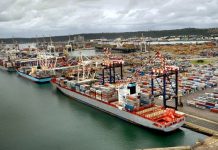Carriers are set to enjoy a US$9 billion bonanza as a result of their successful capacity management programme throughout the pandemic period, which is set to continue into the third quarter.
Alan Murphy at Sea-Intelligence believes that the carriers have created a situation as a result of the Covid-19 crisis where they have a choice, start a rate war, the old style of competition, which could lead to a loss of US$7 billion or to maintain and raise rates and make a profit by continuing to manage capacity and costs.
According to Murphy the major liner shipping operators have revised the scenario’s through careful capacity management.
“When the first estimate of carrier profitability was made in April, two key scenarios were made. Both assumed a 10% loss of volume. One then assumed stable freight rates which would lead the carriers to a loss of US$800 million. The other assumed a ‘normal’ freight rate war in a weak environment leading to a US$23 Billion loss. The stark difference led us to predict that carriers would strive hard to maintain freight rates through capacity management,” commented Murphy.
However, far from maintaining freight rates the lines have gone much further and raised rates considerably, particularly on the major east to west trade lanes, while the pandemic and oil glut has also decreased costs substantially, improving the lines’ profitability further.
In fact Murphy believes that the carriers went too far in their capacity management programme on the Pacific and the result has been rolling of cargo and some reinstatement of vessels.
“The data shows that most main trades continue to see an increase in the amount of blank sailings as carriers clearly expect a depressed demand situation to continue into Q3 2020. However, the Transpacific trade to North America West Coast is currently seen to diverge from the development of the other key deep-sea trades. Where other trades maintain the levels of blank sailings, or increase them, the North America West Coast trade is currently seeing a significant reduction in blank sailings,” argues Murphy.
Data releases do not show a significant rebound in cargo volumes on the Pacific trades, “If this was the case, we should expect a similar development in the Transpacific trade to North America East Coast as well as the North and South Atlantic trades – but that is not what the data shows,” said Murphy.
He added, “The data therefore supports the notion that the carriers had simply removed too much capacity from the West Coast trade for a period, and now need to ensure sufficient capacity is available address the resultant roll-pool of cargo. Once this is addressed, the blank sailings level is set to rise again.”
Nevertheless, Alphaliner reports a decrease in the number of idle vessels by 110,000TEU, down to 521 ships totalling 2.61 million TEU. A trend that Alphaliner expects to continue into the future.
A substantial element of the idled ships are those waiting to fit exhaust gas cleaning systems (EGCS), some 24% of the inactive fleet according to Alphaliner, or 614,000TEU.
Alphaliner also points to the long queues of vessels waiting to be scrapped at anchorage off the Indian Sub-continent, including eight container ships beached since the end of May.
However, shipbroker Braemar says that some vessel owners may be delaying the fitting of scrubber technology, waiting to see if the price spread between low sulphur and high sulphur content fuel increases after the crash in the price of crude oil in March and April hit saw the collapse in bunker fuel prices too.
Jonathan Roach, a researcher at Braemar believes there will be some reckoning in the container ship fleet as the Covid-19 pandemic has hit volumes, with the expectation that the decline in demand will be a long-term structural problem rather than a short-term blip that sees a return to pre-viral operations.
In particular Roach said that the feeder operators have seen volumes hard hit and there is an expectation that rail may take some of the cargo volume from feeder ships on a more permanent basis.
In addition, Roach concedes that while a significant number of container ships in the current fleet are over 20 years old, these are smaller feeder vessels, “they are not being sent to fit scrubbers,” confirms Roach, “ that only makes sense for the larger ships”.
Feeder vessels are more likely to be in line for scrapping and with the number of replacements, in terms of new orders, remaining low the crunch for the feeder industry in both Asia and Europe could have been accelerated by the pandemic.
Nick Savvides
Managing Editor





